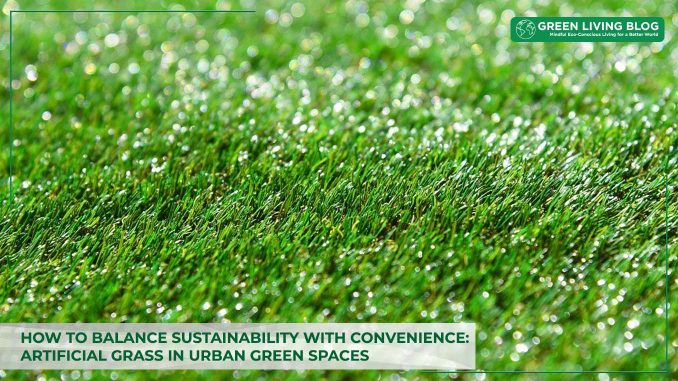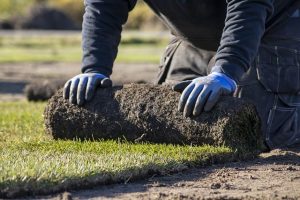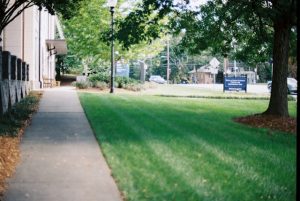
Green spaces in cities provide more than visual beauty because they enhance air quality, lower temperatures, and create essential recreation spaces.
Maintaining natural grass can be difficult. Water scarcity, high maintenance costs, and limited space often leave urban planners searching for practical alternatives. Artificial grass has emerged as a solution, offering year-round greenery with minimal upkeep.
Therefore, this article explores the use of artificial turf in urban green spaces, focusing on its practicality. It also addresses ways to minimise its environmental impact by exploring eco-conscious practices like recycling options and sustainable installation methods.
The Role of Artificial Turf in Urban Landscaping

Artificial turf plays a significant role in urban landscaping, particularly where maintaining natural grass is impractical. For instance, the challenges include limited space, water scarcity, and high maintenance demands, making artificial grass an attractive alternative. Its year-round greenery adds visual appeal to parks, rooftops, playgrounds, and courtyards, creating inviting spaces without the constant upkeep required by natural lawns.
Opting for professional turf installation is generally better than a DIY approach, particularly for those who want a long-lasting, high-quality result. While a DIY project might seem cost-effective, it often comes with hidden challenges and risks that can affect appearance, durability, and performance.
Premium residential turf installation services ensure a high-quality, durable product and a professional finish that enhances your outdoor space. Expert installation services also ensure proper groundwork, which is crucial for long-term performance.
Once installed, expect the following benefits:
1. Water-Saving Benefits
One of the most notable advantages of artificial turf is its water-saving benefit. Unlike natural grass, it doesn’t require regular irrigation, which is especially crucial in regions experiencing droughts or water restrictions. It makes it a sustainable choice for cities aiming to conserve water while still providing residents with green spaces.
2. Low-Maintenance Appeal
Low maintenance is another key factor. Artificial grass eliminates the need for mowing, fertilising, and replanting, saving time and resources for both private and municipal users. It also maintains its appearance regardless of weather conditions, ensuring that public spaces remain clean and accessible throughout the year.
In winter, it resists damage from frost, although ice accumulation may require occasional attention for safety. On the other hand, heat retention can be a concern in summer, but modern turf designs with heat-reducing technology help mitigate this issue, keeping surfaces cooler and more comfortable.
3. Versatility in Urban Spaces
It can be installed in unconventional locations like rooftops or terraces, turning unused areas into functional and visually appealing spaces. Additionally, it is durable enough to withstand heavy foot traffic, making it ideal for playgrounds, sports fields, and other communal areas.
5 Tips for Minimising Environmental Impact

1. Choose Sustainable Materials
Traditional turf often relies on non-biodegradable plastics and synthetic infills, which can take decades to decompose. Hence, many manufacturers are incorporating recycled or biodegradable materials. For instance, some turfs are made from recycled plastics like old water bottles or fishing nets, giving these materials a second life and reducing waste.
Biodegradable options are also becoming more available, designed to break down naturally over time without leaving harmful residues. Hence, when selecting turf, look for certifications or labels that verify its sustainable origins. This simple step ensures your choice contributes to reducing the environmental burden of production.
2. Implement Eco-Conscious Installation Practices
Proper installation can make a significant difference in the environmental impact of artificial turf. Thus, a permeable base layer allows rainwater to drain naturally into the soil, maintaining groundwater levels and preventing urban flooding. Without this, it can cause water pooling and exacerbate runoff, issues already affecting many cities.
Avoid using adhesives or other non-biodegradable materials during installation. Instead, opt for mechanical fixes or eco-friendly alternatives that allow the turf to be more easily removed and recycled at the end of its lifecycle. Further, combining artificial turf with natural greenery, like planting trees or incorporating flower beds, creates a more balanced and eco-friendly urban environment.
3. Maintain Artificial Turf Responsibly
While artificial turf requires less maintenance than natural grass, responsible care can further reduce its environmental impact. For cleaning, use water sparingly and avoid harsh chemicals. Instead, use biodegradable cleaning solutions to clean your turf without releasing toxins.
Further, regular maintenance, like brushing the turf to prevent compaction and removing debris, helps extend its lifespan. The longer your turf lasts, the less often it will need replacing, reducing the environmental cost of manufacturing and disposal. Investing in occasional professional maintenance can also keep your turf in optimal condition, ensuring it stays functional and visually appealing for years.
4. Recycle and Plan for Disposal
One of the most significant concerns about artificial turf is what happens when it’s no longer usable. Planning for its end of life can make a huge difference in minimising environmental harm. Many companies now offer recycling programs to repurpose old turf into new products, such as playground surfaces or new turf.
In addition, some manufacturers have implemented closed-loop systems, where used turf is collected, processed, and turned into fresh materials for future installations. Thus, when choosing a provider, ask about their recycling or take-back schemes to ensure a sustainable disposal process.
5. Combine with Natural Solutions
Artificial turf doesn’t have to replace natural greenery entirely. Instead, it can complement it. For instance, using turf in areas where natural grass struggles to grow while preserving nearby soil for native plants can create a balanced and sustainable landscape. Native plants can support local biodiversity, attracting pollinators and other wildlife, often lost in purely artificial environments.
Conclusion
Artificial turf offers a practical solution for urban spaces, especially where maintaining natural grass is difficult. For instance, it provides a year-round green aesthetic without constant watering, mowing, or fertilising, making it ideal for areas facing water restrictions or high maintenance costs. In addition, its durability ensures it can withstand heavy foot traffic, making it suitable for parks, playgrounds, and rooftops.
Further, its versatility allows you to transform underutilised spaces, such as concrete courtyards or small terraces, into functional and inviting environments. With thoughtful choices regarding materials and installation, artificial turf can meet urban landscaping needs while reducing resource consumption.
![]()
Author Profile

- Eco Warrior by day, Eco Blogger by night trying to get the eco balance right.
Latest entries
 Green GuidesNovember 3, 2025The Beginner’s Guide to Making Your Own Nontoxic Candles at Home
Green GuidesNovember 3, 2025The Beginner’s Guide to Making Your Own Nontoxic Candles at Home Green Home GuidesOctober 14, 2025What are Eco-Friendly Tissue Options for Modern UK Homes?
Green Home GuidesOctober 14, 2025What are Eco-Friendly Tissue Options for Modern UK Homes? Best practicesSeptember 17, 20253 Ways Young Families Can Commit to Sustainable Living
Best practicesSeptember 17, 20253 Ways Young Families Can Commit to Sustainable Living EnvironmentSeptember 9, 2025Eco-friendly Gardening on a Budget: 6 Sustainable Choices that make a Difference
EnvironmentSeptember 9, 2025Eco-friendly Gardening on a Budget: 6 Sustainable Choices that make a Difference





Leave a Reply
You must be logged in to post a comment.